Abstract
In this paper, a comparison of positive streamer diffusion propagation is carried out in three configurations of oil transformers: mineral transformer oil, mineral oil with solid dielectric barriers, and a nanofluid. The results have been solved using a finite-element method with a two-dimensional (2D) axi-symmetric space dimension selected. Additionally, previous results from other research has been reviewed to compare the results obtained. As expected, it is confirmed that the nanoparticles improve the dielectric properties of the mineral oil. In addition, it is observed that the dielectric solid blocks the propagation of the streamer when it is submerged with a horizontal orientation, thus perpendicular to the applied electric field. The computer used, with four cores (each 3.4 GHz) and 16 GB of RAM, was not sufficient for performing the simulations of the models with great precision. However, with these first models, the tendency of the dielectric behavior of the oil was obtained for the three cases in which the streamer was acting through the transformer oil. The simulation of these models, in the future, in a supercomputer with a high performance in terms of RAM memory may allow us to predict, as an example, the best concentration of nanoparticles to retard the streamer inception. Finally, other dielectric issues will be predicted using these models, such as to analyze the advantages and drawbacks of the presence of dielectrics inside the oil transformer.
1. Introduction
Transformers are an important part of the electric power system, because they allow us to modify the voltage of electric energy. Transformers make it possible to combine a high transport voltage (which helps to reduce transport losses) with a low voltage in the consumption (necessary to guarantee the safety of the users).
Electrical insulation is the main component of electrical devices such as power transformers, power cables, engines and electric generators. In transformers, different types of insulation systems, such as solids and liquids, which are widely used in transformers, can be found.
The most widely used dielectric liquid in power transformers is mineral oil. This is because it has better insulating properties and a higher thermal conductivity than gaseous insulation systems [1]. In addition, it is auto-regenerated in the case of short-discharges, which means that it is not significantly deteriorated by partial discharge (PD) activity, unlike solid insulation.
Transformer oil is occasionally submitted to abnormally high levels of electric field. If these levels are maintained for a long enough time, it can produce ionization of the oil molecules, which can lead to a streamer, which is a precursor of the electric arc that provokes the total dielectric breakdown of a dielectric. Generally, the mean velocity of positive streamer propagation is about 10 times larger than that for the negative needle in oil liquid insulation for power transformers [2]. For this reason, positive applied voltages can lead to positive streamers with a greater risk for the insulating fluids than negative streamers, as a result of the dielectric breakdown that occurs at lower voltage values and with shorter breakdown times than negative streamers [3,4].
During the previous years, the properties of insulating oils have been investigated to improve their dielectric and thermal behavior [1,5]. Lately, most research has been focused on identifying the advantages and disadvantages of adding nanoparticles into transformer oil [6]. The oil and nanoparticle assembly is commonly referred to as a nanofluid.
Nanotechnology is a field of sciences that is dedicated to the study, control and manipulation of elements whose dimensions are smaller than micrometers. Therefore, it is applied to scales of atomic and molecular level. Nanotechnology is widely used in the food, electronics or medicine industries.
Other key research aimed at improving the dielectric properties of oil focuses on the dielectric solids submerged in the oil. Experimental tests have demonstrated that submerged dielectric solids can facilitate or block the streamer diffusion. The present document studies the influence of dielectric solids perpendicular to the direction of the streamer. This is because of the fact that this configuration blocks the diffusion of the streamer, whereas the position parallel to the streamer facilitates its progress [7].
In addition to the experimental measurements, the use of finite-element software allows for a faster advance in the study of the results obtained for the dielectric rupture of transformer oil [7,8].
O’Sullivan [8] presented his PhD thesis on the development of streamers in mineral transformer oil. Then, Hwang [7] improved the O’Sullivan model by increasing the breakdown voltage, adding nanoparticles and immersed solid barriers. Later, Jadidian [9] improved the propagation model of the streamer, studied the effect of different immersed dielectrics and constructed three-dimensional (3D) models for simulating streamer branches.
This paper focuses on the comparison of positive streamers in three different systems: mineral oil, nanofluids and immersed dielectric solids in mineral oil. For the study of the cases mentioned above, simulations have been implemented in Comsol Multiphysics using the electrodynamic model developed by researchers at the Massachusetts Institute of Technology (MIT) and ABB Corporate Research [7,8,9]. The geometry used for the simulations corresponded to the International Electrotechnical Commission (IEC)-60897 [10], with a gap of 25 mm. The voltage was applied in the form of a step with a rise time of 10 ns.
The paper is structured as follows: Section 2 explains the geometric characteristics of the tip-sphere electrodes corresponding to the IEC-60897 [10]. Section 3 exposes the theoretical basis of the models implemented to simulate the cases mentioned above. The results for the simulations obtained are shown in Section 4, the challenges for the streamer simulation are described in Section 5, and the conclusions are presented in Section 6.
2. Oil Test Specimen
The geometry used in the realization of the simulations is included in the IEC-60897, Methods for the determination of the lightning impulse breakdown voltage of insulating liquids [10].
The configuration consists of a cell with two electrodes. The first has a spherical tip with a radius of between 40 and 70 , and the second has a spherical shape with a diameter of between 12.5 and 13 mm. The spherical electrode is connected to the ground and a potential is applied to the spherical tip electrode. The separation between the electrodes can vary between 10 and 25 mm, and the cell must contain around 300 mL of oil. The geometry of the simulated cell is shown in Figure 1.
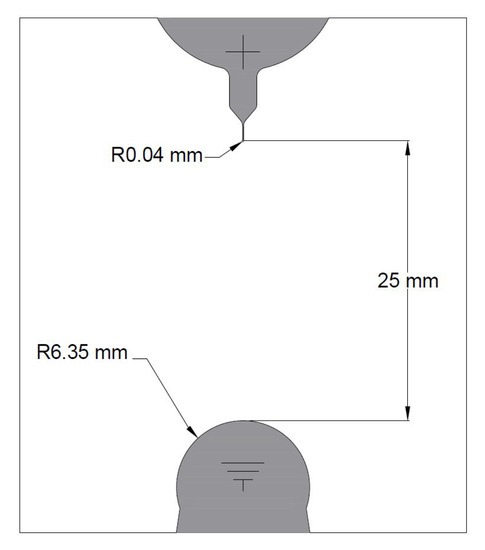
Figure 1.
Geometry corresponds to International Electrotechnical Commission (IEC)-60897 [10].
3. Streamer Model
Several studies have shown that the key phenomena in the development of streamers is the direct ionization of the oil molecules, as a result of the action of the electric field. When high levels of electric field are reached, the ionization of the oil takes place, creating free charge carriers. Another source of charge are the generated electrons coming from the cathode as a result of the electric field. This creates a flow of electrons from the cathode to the anode. This flow of charges creates a conductive path called a streamer [11].
There are different mechanisms that take place in the ionization process of transformer oil. These methods have been studied by O’Sullivan [8] and Hwang [7], who have concluded that the most important mechanism that participates in the ionization of the oil is the molecular ionization, dependent on the electric field, the “field ionization”.
The models developed by O’Sullivan [8], Hwang [7], and Jadidian [9] are used as a basis for the development of the three case studies. For modeling the streamer, Jadidian [12] used the computer configuration shown in the first column of Table 1 at the MIT, while the configuration that has been used in this study at Escuela Técnica Superior de Ingeniería y Diseño Industrial (ETSIDI) is that shown in the second column. As depicted in Table 1, the MIT’s computer has approximately 12 times more RAM than the computer used at ETSIDI, which allowed us to implement 7.2 degrees of freedom instead of 2 degrees of freedom, allowing for a more accurate model and requiring a time simulation close to 20 h, four times longer than the model implemented with the ETSIDI’s configuration. The following sections explain the models that allowed us to perform the simulations and the subsequent comparison of the obtained results.

Table 1.
Computers used for streamer simulation in oil transformers at Massachusetts Institute of Technology (MIT) and at Escuela Técnica Superior de Ingeniería y Diseño Industrial (ETSIDI).
3.1. Streamers in Mineral Transformer Oil
The equations that control the behavior and interaction between the oil particles used for the simulations of the oil ionization and afterward the propagation of a streamer were developed by O’Sullivan [8] and Hwang [7].
The most widely used equation among the scientific community for modeling the field ionization ratio is based on the Zener tunneling model [13], and the mathematical expression of the density of the ionization field is as follows:
where is the module of the electric field vector, ) is Planck’s constant, is the charge of the electron, is the mass of the electron in the ionization proces, is the intermolecular distance, is the density of ionizable species, and is the electrical potential needed for the molecular ionization. Jadidian [9] found that the last four above-mentioned parameters are the most difficult to determine, because they depend on the chemical nature of the oil.
It could be said that almost all of the parameters are constant. Only the electric field is variable, because it depends on the geometry and the applied voltage.
To model the propagation and behavior of the free charge carriers in mineral oil, continuity equations have been used. The free charges in the oil are positive ions (Equation (2)), negative ions (Equation (3)), and electrons (Equation (4)). At the metal-liquid interface, positive ions and electrons are generated, but negative ions are not. Therefore, the electrons are injected from the electrode into the liquid, generating in turn positive ions, while the generation mechanism of negative ions is different because they are generated later by collisions, as depicted in [7,8].
where , and are the space charge density of positive and negative ions and electrons, respectively; , and are the mobility of electrons and negative and positive ions, respectively. and are the ion-ion and electron-ion recombination ratios for the oil, respectively.
The three continuity equations are linked by the Poisson equation [14]. With this equation, it is possible to relate the variation of the electrical potential to the density of free charges in the oil. The Poisson equation is the following:
where and is the relative permittivity of the oil.
During the propagation of the streamer, there is heat dissipation due to the Joule effect. The oil temperature is related to the Joule heating through the product E·J, where J () is the total current density. These equations are as follows:
where is the oil density, is the thermal conductivity of the oil, is the specific heat, is the temperature of the oil and is the velocity of the oil, which can be considered negligible because of the fact that the streamer propagation time is on the scale of microseconds to nanoseconds.
The values of previously mentioned parameters are set out in Table 2 [8].

Table 2.
Parameters used in the simulations for oil characterization.
3.2. Streamer in Nanofluid
The latest technological advances in this field have focused on improving the resistance to rupturing and the thermal behavior of the insulation. In this section, the effect of adding nanoparticles to the dielectric oils on the streamer formation is analyzed. These dielectrics have rupture voltages higher than for mineral oils; this is because the electrons are attracted to the nanoparticles, remaining attached to them and preventing their free movement [15].
In this model, it has been assumed that the nanoparticles have a perfect conductivity; when a potential affects them, they are perfectly polarized. For this to be possible, the electrons have to be deposited uniformly on the surface of the nanoparticle.
The effect of attracting electrons to the nanoparticle is called charge. This process takes place until the surface is completely covered with electrons; when this happens the nanoparticle is saturated and cannot attract more electrons. Therefore, charge only occurs in areas where the radial component of the electric field at the surface is positive. The equation governing the charge of the nanoparticle is the following [7]:
where is the oil’s permittivity, is the electric field, R is the radius of the nanoparticle and is the time-dependent function of the nanoparticle charge. The saturation charge is given when has a value of 1; therefore the formula of saturation charge is the following [7]:
Another important parameter to characterize the nanoparticle is the time constant. The time constant is the time during which the nanoparticle influences the electrodynamic development of the streamer. The equation for obtaining the time constant of the nanoparticles is the following [7]:
The mobility of the electrons is higher than that of the ions; therefore, the nanoparticle captures them faster. By this fact, the nanoparticle becomes a negative charge in motion. The equation that determines the movement of the nanoparticle in the oil is the following [7]:
where the kinetic viscosity is .
The development of the model with nanofluids is based on that described for the propagation of streamers in mineral oil. These equations have to be slightly modified to include the influence of the nanoparticles. The controlling equations of the model are the following [16]:
where , and are the espace charge density of positive and negative ions and electrons, respectively; , and are the mobility of electrons and negative and positive ions, respectively. and are the ion-ion and electron-ion recombination ratios for oil, respectively; is the electron attachment time constant, (kgm) is the oil density, is the thermal conductivity of the oil, is the specific heat, T is the temperature of the oil, is the velocity of the oil, is the time constant of nanoparticles and is the step function that determines the saturation of the nanoparticles. The current density is also affected by the nanoparticles; the corresponding equation is [7].
The saturation of the nanoparticles is determined by the function; thus it is necessary to determine the number of electrons that are able to be attracted to its surface. The first step is to determine the volume of nanoparticles in the fluid. To do this, it is necessary to compare the magnetic saturation of the fluid with the saturation of the nanoparticles [7]:
The maximum charge density of electrons that can be deposited on the surface of the nanoparticle, whose volume is , is the following [7]:
The values of the new parameters used in the model with nanofluids are set out in the Table 3 [7]:

Table 3.
Values of the new parameters used in the streamer simulation for nanofluids.
The nanofluid has been modeled using nanoparticles with a radius of 5 nm and a maximum load of = 500 ; this is because the charge of the nanoparticles reaches values close to 80%, and therefore a value at infinity is not adequate [7]. A magnetization domain of 0.56 T has been considered. It has also been assumed that the nanoparticles have perfect conductivity, that is, when an electric field falls on them, they are perfectly polarized.
3.3. Streamer in Oil with Dielectric Barrier
One way of improving the insulation properties of a liquid is to immerse a dielectric solid oriented perpendicular to the direction of propagation of the streamer. During its propagation, the streamer stumbles upon the solid dielectric, impeding its advance [7]. This dielectric solid enables the liquid to withstand an applied voltage higher than that obtained for mineral oil.
Because of the difference in permittivity between the solid dielectric and the oil, there is an attraction of free charge carriers toward the solid because of the force of polarization. This creates a path of spatial density of free charge carriers accumulating on the surface of the solid dielectric where the streamer would propagate.
In this paper, simulations have been performed for three different cases of immersed dielectric solids. These three solid dielectrics have different relative permittivities; therefore, it has been possible to study the effect of permittivity differences on streamer propagation. The solid dielectrics that have been used are the following: polytetrafluoroethylene (PTFE), polyethylene terephthalate (PET) and Pressboard, whose relative permittivities are 2.2, 3.3 and 4.4, respectively.
To model the liquid-immersed dielectric solid system, some equations have been added to those indicated above in Section 3.1. These are Equations (21) and (22), which govern the submerged dielectric solids, and Equation (23), which models the dielectric liquid–solid contact zone. These equations were developed by Hwang [7] and Jadidian [9].
where is the relative permittivity of the solid dielectric; is the vacuum permittivity, whose value is ; is the current density; and is the surface charge density that appears on the contacting surface between the dielectrics.
The geometry used in this case is that shown in Figure 2. It consists of the geometry depicted in the IEC-60897 [10] standard, maintaining a gap of 25 mm between the electrodes, but with the dielectric solid placed 0.5 mm from the tip of the positive electrode (z-axis).
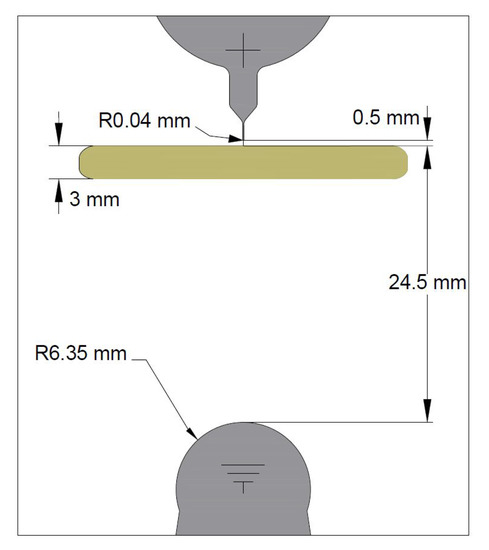
Figure 2.
Solid dielectric immersed geometry.
4. Results of Positive Streamer Simulation
In this section, three models have been implemented for obtaining streamers in different oil transformer configurations. First, we describe the streamer in mineral transformer oil, in accordance with the model described in [8]. Second, we give the streamer in mineral transformer oil with nanoparticles, where we have implemented the model implemented in [7] with two different time constants of the nanoparticles, = 50 ns and = 20 ns, added. Finally, the streamer in mineral transformer oil with immersed dielectric solids has been simulated, in accordance with [9]. To allow for the comparison, the applied voltage was 300 kV for all the cases analyzed.
In the next two subsections, the following graphical representations are shown:
- Streamer propagation
- Net space charge
- Electric field
- Electric potential
- Temperature
In the third subsection, the graphical representation is presented of the streamer propagation at different time steps when three different solid dielectrics with permittivity values = 2.2, = 3.3 and = 4.4, respectively, were used.
4.1. Streamer in Mineral Transformer Oil
As can be seen in Figure 3, ions and electrons are attracted by the electric field between electrodes in such a way that the maxima of electrical charge are displaced. The net space charge density is shown in Figure 4a. In turn, this provokes a displacement of the electrical field, as shown in Figure 4b. The electric potential also changes with time (Figure 4c).
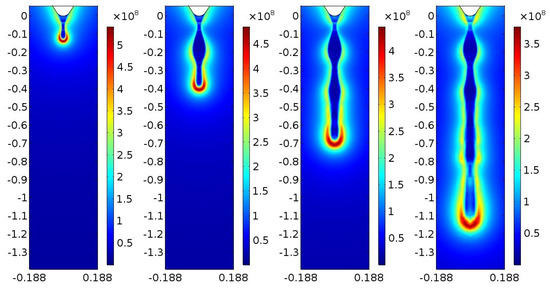
Figure 3.
Positive streamer propagation. Evolution of the electric field in mineral transformer oil along the z-axis, applying 300 kV and with a rise time of 10 ns.
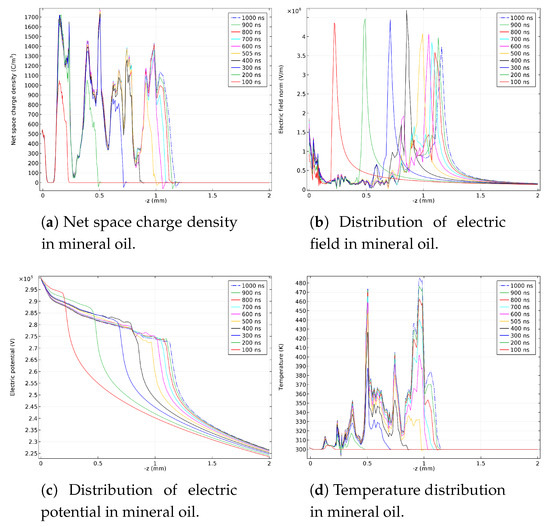
Figure 4.
(a) Net space charge density, (b) distribution of electric field, (c) distribution of electric potential, and (d) temperature distribution along the z-axis from t = 0 to 1000 ns in intervals of 100 ns from the simulations in mineral transformer oil.
The region of maximum temperature is given by the points of space in which the ions are. As time passes, more free ions are produced, but while there is no avalanche phenomenon, the net number of charges formed is not high, and the temperature does not increase appreciably (Figure 4d). The increase in temperature is because the temperature is directly proportional to the electric field and the current density.
In mineral oil, a displacement of the electric field (Figure 4b) and the potential (Figure 4c) occurred as a result of the ionization of the oil. In accordance with real data presented in [17], an electric field level greater than is required to initiate a positive streamer in mineral oil. Therefore, the simulation results presented in this work are in agreement with those results presented through simulation in [8] and by real data in [17].
4.2. Streamer in Nanofluid
In order to study the influence of the time constant on the streamer process, in this subsection, simulations performed for two different time constants of = 50 ns and = 20 ns are discussed. These time constants of the nanoparticles added to the base fluids, indicating the time that it took for the nanoparticles to be charged.
4.2.1. Nanofluids with = 50 ns
When nanoparticles were added to the oil, the concentration of electrons was reduced. Therefore, the speed of the streamer propagation along the z-axis was reduced (Figure 5) compared with that in mineral oil (Figure 3). The space charge density was also somewhat reduced (Figure 6a) in the nanofluid compared with that in the base fluid, along the z-axis (Figure 4a). For this reason, the electric field advanced slowly (Figure 6b), and as did the electric potential (Figure 6c). Finally, it is shown in Figure 6d that the streamer temperature was also reduced.
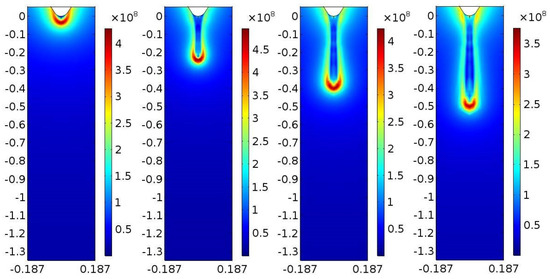
Figure 5.
Positive streamer propagation. Evolution of the electric field in nanofluids with = 50 ns along the z-axis, applying 300 kV and with a rise time of 10 ns.
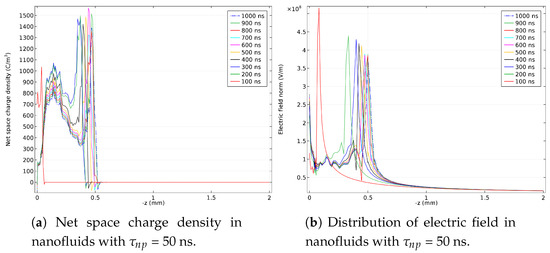
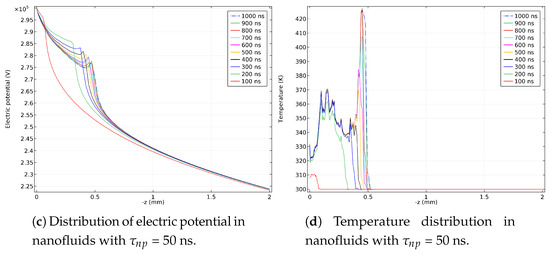
Figure 6.
(a) Net space charge density, (b) distribution of electric field, (c) distribution of electric potential, and (d) temperature distribution along the z-axis from t = 0 to 1000 ns in intervals of 100 ns from the simulations in nanofluids with = 50 ns.
4.2.2. Nanofluids with = 20 ns
As the nanoparticle constant became smaller, the length of the streamer slightly decreased (Figure 7), and this was also observed for the net space charge density (Figure 8a). This was because the nanoparticles charged faster, which reduced the length of the streamer. The electric potential and temperature were also slightly reduced compared with the case of = 50 ns nanoparticles. Thus, when the time constant of the nanoparticles was reduced from = 50 ns to = 20 ns, this reduced the streamer speed and temperature; thus the probability of an electrical breakdown is diminished for an applied voltage of 300 kV, under these conditions.
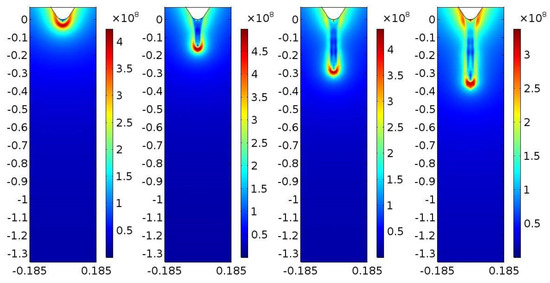
Figure 7.
Positive streamer propagation. Evolution of the electric field (V/m) in nanofluids with = 20 ns along the z-axis, applying 300 kV and with a rise time of 10 ns.
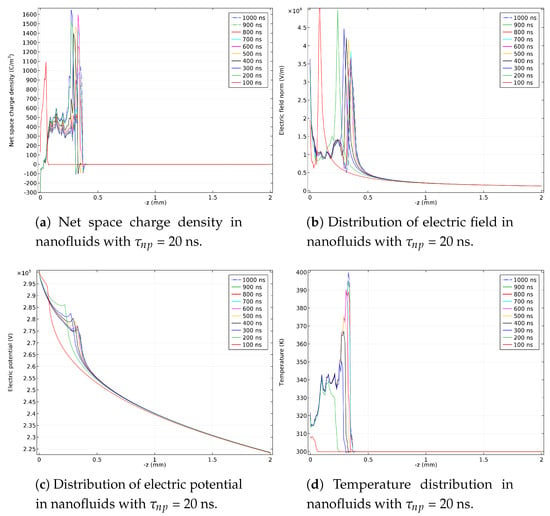
Figure 8.
(a) Net space charge density, (b) distribution of electric field, (c) distribution of electric potential, and (d) temperature distribution along the z-axis from t = 0 to 1000 ns in intervals of 100 ns from the simulations in nanofluids with = 20 ns.
In accordance with [7], it was shown that the addition of nanoparticles with a time constant of 50 ns could reduce the electric field from 6 V/m in mineral oil to 5.5 V/m in the nanofluid. Additionally, the streamer propagation velocity for the nanofluids was slower than that of the mineral transformer oil. These results are in agreement with those obtained experimentally in [18], where it is shown that the presence of conductive nanoparticles in mineral oil reduces the positive streamer propagation velocity. In [7], the model resulted in an average positive streamer velocity decrease from 1.65 km/s in mineral transformer oil to 1.05 km/s in the nanofluid; these are velocities very close to those obtained experimentally by [18]. In Table 4, a comparison is shown between simulation results obtained for positive streamer propagation in mineral oil and nanofluids when a voltage set at U = 300 kV is applied to the geometry shown in Figure 1. The positive streamer length obtained was 1.2 mm for mineral oil, instead of 1.6 mm presented in [8]. Additionally, the velocity for mineral oil was 1.2 km/s; this was 0.707 km/s for nanofluids with nanoparticles of = 50 ns and was 0.593 km/s for nanofluids with nanoparticles of = 20 ns. These differences were mainly because of the challenges for streamer simulation described in Section 5.

Table 4.
Comparison between positive streamer propagation in mineral oil and mineral oil with nanoparticles.
4.3. Streamer in Base Fluid with Dielectric Barrier
When a dielectric solid is immersed with a perpendicular orientation to the electric field, the streamer is prevented from continuing to propagate; this forces the streamer to pass through or surround the solid, thereby delaying the electrical breakdown. Below, four time steps of simulations are shown for when a solid dielectric was immersed in the base fluid with three different relative permittivities.
For the three cases studied, , and , it was verified that the streamer impacted with the immersed solid as a result of its orientation (Figure 9a–c, respectively).
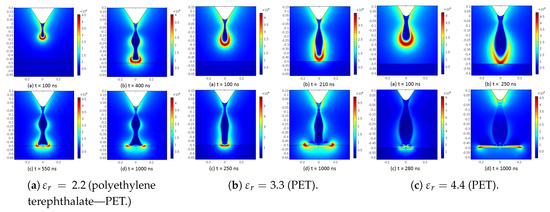
Figure 9.
Positive streamer propagation. Evolution of the electric field (V/m) in mineral oil transformed with a horizontal solid barrier with (a) (polytetrafluoroethylene—PTFE), (b) (PTFE), and (c) (PTFE), applying 300 kV and with a rise time of 10 ns.
5. Challenges for Streamer Simulation
The main challenges for the simulation of the streamer in liquid dielectrics with finite-element software were as follows:
- Because of the scale of nanometers on which the simulations of the streamer were carried out, as well as the complex shapes of the geometry used, it was necessary to use a fine meshing (dividing the geometry into a high number of finite elements) to obtain results with sufficient precision. In addition to this, the number of linear and highly nonlinear equations introduced into the model had to be considered. Therefore, it was necessary to increase the number of cores used, for example, up to eight cores, and keep the frequencies for the processors above 3–3.5 GHz, working at the same time to be able to solve the model with acceptable times to carry out the simulations.
- Regarding the RAM memory, using a direct solver such as the multifrontal massively parallel sparse direct solver (MUMPS) reduced the use of RAM memory without requiring the use of a great resource of memory. This was possible because it stores part of the solution out-of-core, which means that part of the memory is stored on the hard disk. This behavior has the advantage of reducing the use of RAM memory, but it slows down the process, as it has to read data from the hard disk.
- The use of a graphics card was important at the time of the calculations and also at the time of visualizing the results. We note that it was not as critical a parameter as those previous. As an example, a Nvidia GeForce 940 with 4 Gb DDR3 had a good behavior for the simulations.
- Finally, to improve the performance and accuracy of the model, Equation (24) was used, which allowed us to reduce the oil rupture voltage to more realistic values:where is the electric field-dependent ionization potential function, whose value is obtained as follows:Here (eV) is the electrical potential needed for the molecular ionization and is the ionization potential function parameter. This theory is described by Jadidian in [9]. This model for dielectric liquids has been previously used to explain streamer propagation mechanisms for water and liquid dielectrics in [19,20,21,22]
- The difference between Equations (24) and (1) is that in the new equation, a continuous feedback of the value of the vector of the electric field is obtained, as a result of the new parameter . Therefore, an evolution that is more consistent with the reality of the field ionization ratio, , is achieved.
6. Conclusions
The analysis of the dielectric and thermal behavior of the insulation system used in electrical assets such as the oil of power transformers is of interest for improving this kind of solid-liquid insulation system.
The work presented in this document allows us to have several models in finite-element software for analyzing the streamer behavior in several scenarios, such as in transformer oil, in a nanofluid and in transformer oil with solid dielectrics immersed. In accordance with the results obtained in this work, the following conclusions can be described:
- In mineral oil, a displacement of the potential and the electric field occurs as a result of the ionization of the oil (at field levels around (V/m)). By ionizing more oil, a greater generation of charge carriers is obtained; this is shown in the figures on the net space charge density, generating a driving path where there is current conduction and therefore the advance of the streamer. This circulation of current causes an increase in temperature.
- When applying nanoparticles, the displacement of the positive streamer along the z-axis is reduced. In simulations with nanofluids and a time constant of 20 ns, there was a lower displacement of the field and potential in comparison with simulations made with a time constant of 50 ns; this was due to the fact that the nanoparticles were loaded faster for = 20 ns compared with = 50 ns—because of their influence in the streamer, this was accentuated when the time constant was reduced. As for the temperature, this produced something similar: temperatures were reduced, such that the deterioration of the oil was reduced.
- Regarding the barriers immersed inside the mineral oil, for the case of PTFE , as there was no difference in the relative permittivity between the dielectric solid and the oil, the dielectric solid did not attract the carriers of free charges by polarization; therefore, this propagation of the streamer on the dielectric solid was not due to the effects of polarization. However, as a result of the perpendicular orientation of the solid, the streamer, as it propagated, encountered the barrier and produced surface discharges on the dielectric solid that propagated along it. The PET and Pressboard cases were analogous, because their relative permittivities were higher than that of the oil in which they were submerged. Therefore, these dielectric solids attracted the carriers of free charges as a result of the polarization effect. On the other hand, because of the perpendicular orientation of the dielectric solid with respect to the main direction of the electric field, this forced the streamer to meet with it. The greater the difference in relative permittivity compared to the oil, the greater the attraction by polarization and therefore the speed of propagation of the streamer on the surface of the dielectric solid. In addition to the greater difference in relative permittivity, the greater the force of attraction of the dielectric solid to the streamer, the greater the adherence of the streamer to the surface.
Acknowledgments
The authors wish to thank the Spanish Ministry of Economy and Competitiveness (project DPI2015-71219-C2-2-R) for supporting this work. Additionally, they would like to thank MDPI for promoting open access to knowledge, and even more, for providing discounts to reviewers, which helps to publish open access research such as this work.
Author Contributions
Juan Velasco and Ricardo Frascella implemented the models to carry out the streamer simulations and provided the results together with substantive suggestions and comments. Ricardo Albarracín guided the investigation and the writing of the article. Juan Carlos Burgos gave substantive suggestions and guidance for the research. Finally, Ming Dong, Ming Ren and Li Yang contributed in brainstorming for the analysis of the results.
Conflicts of Interest
The authors declare no conflict of interest.
References
- Guerbas, F.; Adjaout, L.; Abada, A.; Rahal, D. Thermal aging effect on the properties of new and reclaimed transformer oil. In Proceedings of the IEEE International Conference on High Voltage Engineering and Application (ICHVE), Chengdu, China, 19–22 September 2016. [Google Scholar]
- Yamada, H.; Sakamoto, S.; Nakao, Y. Studies of the breakdown process in dielectric liquids using high speed photography. J. Electrostat. 1979, 7, 155–168. [Google Scholar] [CrossRef]
- Lv, Y.; Ge, Y.; Li, C.; Wang, Q.; Zhou, Y.; Qi, B.; Yi, K.; Chen, X.; Yuan, J. Effect of TiO2 nanoparticles on streamer propagation in transformer oil under lightning impulse voltage. IEEE Trans. Dielectr. Electr. Insul. 2016, 23, 2110–9878. [Google Scholar] [CrossRef]
- Lv, Y.; Ge, Y.; Du, Q.; Sun, Q.; Shan, B.; Huang, M.; Li, C.; Qi, B.; Yuan, J. Fractal Analysis of Positive Streamer Patterns in Transformer Oil-Based TiO2 Nanofluid. IEEE Trans. Plasma Sci. 2017, 45, 1704–1709. [Google Scholar] [CrossRef]
- Oommen, T.V. Static electrification properties of transformer oil. IIEEE Trans. Electr. Insul. 1988, 23, 123–128. [Google Scholar] [CrossRef]
- Primo, V.A.; García, B.; Albarracín, R. Improvement of transformer liquid insulation using nanodielectric fluids; a review. Electr. Insul. Mag. 2018, in press. [Google Scholar]
- Hwang, J.G. Elucidating the Mechanisms Behind Pre-Breakdown Phenomena in Transformer Oil Systems. Ph.D. Thesis, Massachusetts Institute of Technology, Cambridge, MA, USA, 2010. [Google Scholar]
- O’Sullivan, F.M. A Model for the Initiation and Propagation of Electrical Streamers in Transformer Oil and Transformer Oil Based Nanofluids. Ph.D. Thesis, Massachusetts Institute of Technology, Cambridge, MA, USA, 2007. [Google Scholar]
- Jadidian, J. Charge Transport and Breakdown Physics in Liquid/Solid Insulation Systems. Ph.D. Thesis, Massachusetts Institute of Technology, Cambridge, MA, USA, 2013. [Google Scholar]
- IEC. Methods for the Determination of the Lightning Breakdown Voltage of Insulating Liquids; IEC 60897; International Electrotechnical Commission: Geneva, Switzerland, 1987. [Google Scholar]
- O’Sullivan, F.; Hwang, J.G.; Zahn, M.; Hjortstam, O.; Pettersson, L.; Liu, R.; Biller, P. A Model for the Initiation and Propagation of Positive Streamers in Transformer Oil. IEEE Trans. Dielectr. Electr. Insul. 2008, in press. [Google Scholar]
- Jadidian, J.; Zahn, M.; Lavesson, N.; Widlund, O.; Borg, K. Effects of Impulse Voltage Polarity, Peak Amplitude, and Rise Time on Streamers Initiated From a Needle Electrode in Transformer Oil. IEEE Trans. Plasma Sci. 2012, 40, 909–918. [Google Scholar] [CrossRef]
- Zener, C. A theory of the electrical breakdown of solid dielectrics. Proc. R. Soc. Lond. Ser. A 1934, 145, 523–529. [Google Scholar] [CrossRef]
- Girdinio, P.; Repetto, M.; Simkin, J. Finite Element Modelling of Charged Beams. IEEE Trans. Magn. 1994, 30, 2932–2935. [Google Scholar] [CrossRef]
- Prasath, R.T.A.R.; Roy, N.K.; Mahato, S.N. Mineral Oil Based High Permittivity CaCu3Ti4O12 (CCTO) Nanofluids for Power Transformer Application. IEEE Trans. Dielectr. Electr. Insul. 2017, 24, 2344–2353. [Google Scholar] [CrossRef]
- Hwang, J.G.; Zahn, M.; O’Sullivan, F.M.; Pettersson, L.A.A.; Hjortstam, O.; Liu, R. Effects of nanoparticle charging on streamer development in transformer oil-based nanofluids. IEEE Trans. Dielectr. Electr. Insul. 2010, 107, 014310. [Google Scholar] [CrossRef]
- Beroual, A.; Zahn, M.; Badent, A.; Kist, I.C.; Schwabe, A.J.; Yamashita, H.; Yamazawa, C.; Daniis, M.; Chadband, W.G.; Torshi, Y. Propagation and structure of streamers in liquid dielectrics. IEEE Electr. Insul. Mag. 1998, 14, 6–17. [Google Scholar] [CrossRef]
- Segal, V.; Hjortsberg, A.; Rabinovich, A.; Nattrass, D.; Raj, K. AC (60 Hz) and impulse breakdown strength of a colloidal fluid based on transformer oil and magnetite nanoparticles. In Proceedings of the Conference Record of the 1998 IEEE International Symposium on Electrical Insulation (Cat. No.98CH36239), Arlington, VA, USA, 7–10 June 1998; Volume 2, pp. 619–622. [Google Scholar]
- Devins, J.C.; Rzad, S.J.; Schwabe, R.J. Breakdown and prebreak-down phenomena in liquids. J. Appl. Phys. 1981, 52, 4531–4545. [Google Scholar] [CrossRef]
- Béroual, A.; Tobazéon, R. Prebreakdown phenomena in liquid dielectrics. IEEE Trans. Electr. Insul. 1986, E1-21, 613–627. [Google Scholar] [CrossRef]
- Joshi, R.P.; Kolb, J.F.; Xiao, S.; Schoenbach, K.H. Aspects of plasma in water: Streamer physics and applications. Plasma Process. Polym. 2009, 6, 763–777. [Google Scholar] [CrossRef]
- Li, Y.; Zhu, M.X.; Mu, H.B.; Deng, J.B.; Zhang, G.J.; Jadidian, J.; Zahn, M.; Zhang, W.Z.; Li, Z.M. Transformer Oil Breakdown Dynamics Stressed by Fast Impulse Voltages: Experimental and Modeling Investigation. IEEE Trans. Plasma Sci. 2014, 42, 3004–3013. [Google Scholar] [CrossRef]
© 2018 by the authors. Licensee MDPI, Basel, Switzerland. This article is an open access article distributed under the terms and conditions of the Creative Commons Attribution (CC BY) license (http://creativecommons.org/licenses/by/4.0/).